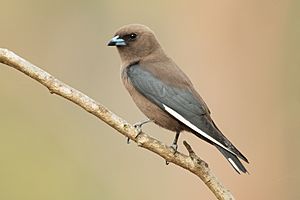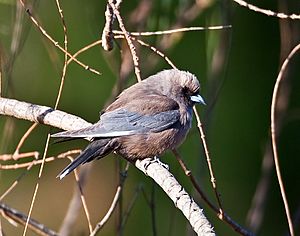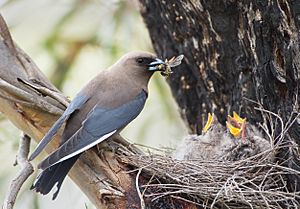Dusky woodswallow facts for kids
Quick facts for kids Dusky woodswallow |
|
|---|---|
 |
|
| Conservation status | |
| Scientific classification | |
| Genus: |
Artamus
|
| Species: |
cyanopterus
|
The dusky woodswallow (Artamus cyanopterus) is a type of bird found in forests and woodlands. It lives in temperate and subtropical parts of eastern and southern Australia. You can also find it in tropical areas around the Atherton Tableland.
Even though we don't have an exact count of these birds, experts believe there are many of them. Because of this, the dusky woodswallow is listed as 'Least Concern'. This means it's not currently in danger of disappearing.
The name "woodswallow" can be a bit confusing. These birds are not actually related to true swallows. Instead, they belong to a family called Artamidae. This family also includes birds like butcherbirds, currawongs, and the Australian magpie.
Contents
About the Name
The dusky woodswallow was first described in 1801 by an English bird expert named John Latham. He gave it the scientific name Loxia cyanoptera. The second part of its name, cyanoptera, comes from two Ancient Greek words. Cyanos means 'blue' and pteron means 'wing'.
What They Look Like
The dusky woodswallow is a medium-sized bird that looks a bit like a swallow. Most of the time, it's dark brown, but sometimes it can look grey. It has a black patch right in front of its eyes. Its wings are grey, or sometimes black, with white streaks.
The tail of a dusky woodswallow is black with a white tip. When it flies, you can see its silver underwing. Its bill (beak) is blue-grey with a black tip. These birds are known for wagging or swiveling their tails a lot. Many other types of woodswallows do this too.
How They Are Different from Other Woodswallows
Dusky woodswallows have a special white patch on the outer part of their wing. This helps tell them apart from other woodswallows. They also tend to be more of a smoky brown color than most other woodswallow species.
The little woodswallow is another type of woodswallow that is also smoky brown. However, it's smaller and darker. The main difference is that the little woodswallow does not have the white patch on its outer wing like the dusky woodswallow does.
Where They Live and Travel
These birds mostly live in open eucalyptus forests and woodlands. You can find them from the Atherton Tableland in Queensland, all the way down to Tasmania. They also live west to the Eyre Peninsula in South Australia.
Dusky woodswallows often sleep together in groups at night. During the time they are raising their young, they gather in large flocks. These flocks can have 20 to 30 birds. This helps them protect their babies from animals that might try to hurt them.
These birds are known to move around a lot. They are a nomadic species, which means they don't stay in one place for long. Birds living in the southeastern parts of Australia will migrate northward when autumn arrives.
Dusky woodswallows make different chattering sounds. One of their most important calls is a harsh sound they make when a predator or intruder comes near. This warns the other birds in the group.
What They Eat
The dusky woodswallow eats many different things. They find leaves and other plant material on the ground or in trees and bushes. They have been seen eating termites, butterflies, and other insects. They also enjoy drinking nectar from flowers.
One interesting way they hunt is by catching flying insects in the air. They also find prey on the ground. They often sit quietly on places like power lines while they wait for food. Sometimes, they even work together to steal food from other birds. For example, they have been seen taking food from a restless flycatcher. This kind of group food-stealing is very rare for these types of birds.
Raising Their Young
The nest of a dusky woodswallow is shaped like a bowl. It's made from twigs, roots, and other plant material, and then lined with soft grass. They build their nests in safe spots, like behind bark, high up in a tree branch, or sometimes inside a hollow tree stump.
They build their nests between August and January. Several birds often help build the nest. Once the nest is ready, the mother and father bird will guard it. Other birds in the group will also help take care of the baby birds. The female bird lays white eggs, usually three or four at a time. The eggs hatch after about sixteen days. The baby birds then stay in the nest for another sixteen to twenty days before they are ready to fly.
How They Are Protected
The dusky woodswallow lives across a very large area. We don't have an exact number for how many of these birds there are. However, they are believed to be very common in the areas where they live. Because of this, the dusky woodswallow is classified as 'Least Concern' (LC). This means they are not currently considered to be in danger. This classification might change in the future if new information comes out.
See also
 In Spanish: Artamo sombrío para niños
In Spanish: Artamo sombrío para niños




